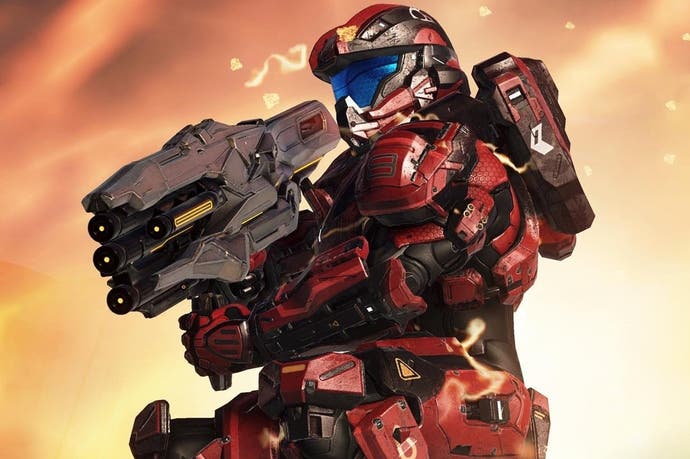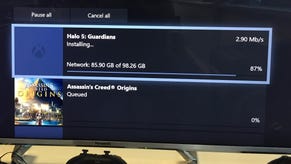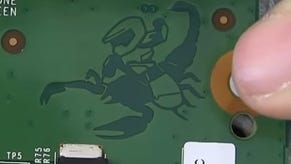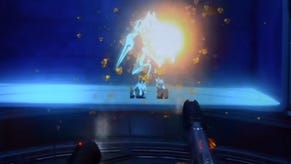Digital Foundry vs the Halo 5 Gamescom demo
Impressions and analysis on the latest campaign reveal.
After surviving the difficult months following the release of Halo: the Master Chief Collection, 343 Industries is just about ready to unleash Halo 5 - the first full-blooded new-gen outing for the franchise. In addition to a revamped multiplayer, the campaign's set to last twice as long as its predecessor, with missions spread across three worlds built on an entirely new graphics engine - so we could well be looking at the most dramatic change in series history. This is not the Halo you know and love, but this new creation still has a lot of potential, with 343i intent on winning over and expanding the series' dedicated fanbase. We were given a chance to check out the latest Halo 5 code behind closed doors this year at Gamescom and walked away impressed by what we saw.
While the E3 campaign reveal focused on the new Spartan - Locke - this new demo focuses instead on the exploits of the Master Chief and his 'Blue Team' as they blast through an Oni research station to retrieve an undisclosed piece of intel. As the second mission in the game, the level feels somewhat more claustrophobic than the E3 demo, yet there's still a surprising amount of freedom available to the player.
The action kicks off as the Chief and friends crash through a window, using thrusters to remain firmly attached to the ship interior as enemies are ejected into space. We had a seat right beside the TV where it was possible to observe the game at close proximity. Aliasing and shimmering are still visible but image quality in general looks like an improvement over the older E3 build. In fact, while we could not record the full demo, the b-roll footage available does indicate that a dynamically scaling framebuffer is in effect, adjusting resolution on the fly according to GPU load. Resolution is still pretty fluid, bottoming out at around 810 lines, while still managing to hit 1080p too (much more consistently in the multiplayer mode). 343i still maintains that a final resolution hasn't been selected, but even now the dynamic scaler works well enough, and we'd be happy to see it in the final shipping game.
The demo continues with the Chief and crew encountering a number of Jackals, Elites, and Grunts in a spacious room. Here it was re-iterated that the campaign is focusing on delivering both a solid single-player and four-player co-op experience. Since this demo was limited to single-player mode, this gave us a closer look at the AI in action. Freed from the overly scripted constraints of the E3 demo, the AI came into its own handling orders and enemies alike in a responsive manner. Simple commands, such as asking one member to pick up a fallen weapon or tackle a distant sniper, seemed to play out smoothly and predictably. Ordering a teammate to take out an Elite's shield, giving you the chance to one shot them is pretty satisfying indeed. It's clear that Tim Longo, creative director on both Halo 5 and Star Wars: Republic Commando, has really put his experience on squad-based shooters into action here to good effect.
Master Chief is also more mobile than before. Ledge-clambering, shoulder-charging, and ground-pounds are all in effect and definitely change the flow of combat. In several instances, carefully designated walls are destroyed with a shoulder barge, leaving enemies unprepared for the assault that follows. Post-processing, particle and debris effects are used in an effective manner giving these moments just the right amount of 'oomph' necessary to convey the size and weight of a Spartan in full flight smashing through a giant metal grate.
The level itself definitely resembles the traditional opening levels one might expect from a Halo game. The angular design of Bungie's games gives way to more flowing level geometry with gentle curves and carefully crafted materials. Lighting and shadow are implemented effectively, creating just the right sort of mood for this rather dark mission. Light plays realistically off of various materials, though we were disappointed that so many effects seemed to lack any sort of dynamic lighting. It's a handsome game at this point but the demo didn't blow our socks off.
Right now, the main visual issue we note from the brief demo is its lack of decent texture filtering. With the heavy reliance on specular highlights on metal panels, the lack of decent texture filtering results in a lot of soupy-looking surface textures that betray the detail present in the assets. It's a problem shared with both Xbox 360 and Xbox One iterations of Halo 4 and it definitely detracts from the experience here. When asked about this, we were told that nothing is final yet but some sacrifices have to be made in order to hit the target frame-rate.
The E3 footage we examined just a month ago gave us cause for concern here with its inability to adhere to a strict 60 frames per second target. Yet, a stable top-tier frame-rate is exactly what the latest build brings to the table. The b-roll analysis suggests very consistent performance for the majority of the duration, and our extended experience with the full demo is consistent with this. Outside of the occasional blip, everything moves at a stable 60fps resulting in the most fluid Halo experience yet - even more so than the Master Chief Collection. When asked about this substantial improvement, we were told that the Gamescom build on display was quite a bit more recent and features plenty of new optimisations made since the E3 code.
Of course, we are dealing with very different content here: the mission shown is rather small in scale and enemy numbers never approached that of the larger Halo battles, and as things stand, it remains to be seen how the game will handle more complex scenarios. When a developer makes the decision to target 60fps, this has an impact on game design as the rendering budget must be kept in check at all times. It's a bold move to aim straight for 60fps with one of the biggest franchises on the Xbox and it will be interesting to see what other compromises may be made to reach this target. Thus far though, we're definitely impressed with the approach 343i is taking here.
On the other hand, cut-scenes operate at 30fps but still manage to look fantastic. An excellent use of bokeh depth of field combined with highly detailed models results in an impressive presentation. Of course, after Halo 4's technologically accomplished, visually superb real-time cut-scenes, this really doesn't come as a surprise. Sound design also seems to be in great shape at this point. Sound effects are, as before, completely different from previous Halo games but come across as suitably powerful. The musical score also leaves quite an impression with themes that feel like a mix of classic O'Donnell-era Halo and the franchise's 343i debut.
At this point, there isn't so much development time left until the game goes gold in preparation for its October 27th release. While we would have loved to revisit the E3 content to see just how far the optimisation effort has actually progressed, the improvements made certainly look promising, definitely suggesting that the 60fps target is being taken very seriously. If 343i can further improve image quality and clean up texture filtering while maintaining this level of performance, we'll be looking at a very handsome release.











